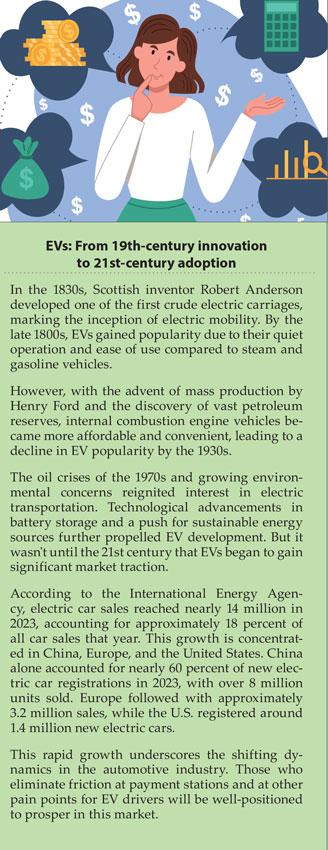The Green Sheet Online Edition
May 26, 2025 • 25:05:02
Eliminate EV charging payment anxiety for sustainable growth

The evolving landscape of electric vehicles (EVs) is transforming the global transportation sector at a rapid pace. Governments worldwide are enacting policies to reduce carbon emissions, automakers are advancing EV design and performance, and consumers are becoming increasingly eco-conscious.
Despite this progress, one major obstacle remains: the inconsistent and overly complex payment processes for EV charging, which lead to payment anxiety among EV drivers. Solving this issue is critical to achieving sustainable growth in the EV market.
Understanding payment anxiety in EV charging
For many EV drivers, the rapid expansion of public charging networks is being undermined by frustrating payment experiences. Unlike the simplicity of refueling conventional cars with a credit card, EV charging often requires navigating multiple apps, memberships or accounts. This fragmented approach creates confusion and inconvenience, potentially discouraging new EV adopters while frustrating current users.
Why EV charging payments must evolve
The demand for seamless EV charging payments arises from three essential factors:
- Consumer expectations for simplicity: Today's consumers have grown accustomed to fast and frictionless payment experiences, whether it's buying coffee with a smartphone or tapping a contactless card on public transport. EV charging payments must rise to match these expectations, offering a simple and convenient payment process.
- Building trust through standardization: A lack of consistency across charging networks often leaves potential EV users feeling alienated. Without a standardized payment system, the experience can feel unnecessarily complicated, lowering confidence in EV technology.
- Scalability for a growing market: The EV market is poised for significant expansion, with growing demand for both charging infrastructure and user-friendly payment systems. A scalable solution that can accommodate more users, integrate innovative payment methods, and manage increased demand efficiently is critical for this growth.
To address these challenges, charge point operators (CPOs) and payment solution providers must join forces to design a payment ecosystem that is intuitive, standardized and easily scalable.
Core components of card-based payments in EV charging
A card-based payment system is one of the simplest solutions for resolving payment challenges in EV charging. It relies on three core elements to deliver seamless transactions:
- Acceptance solutions: These include both hardware and software that enable card payments.
- Card-present transactions – Payments made with a physical card at a POS terminal.
- Card-not-present transactions – Payments completed remotely via the internet, phone or mail.
- Payment gateways: Acting as intermediaries, these gateways connect payment terminals and ecommerce acceptance solutions to financial networks. They process card-present transactions while facilitating ecommerce payments.
- Acquirers: These are financial institutions that handle transactions, ensuring payments are transferred from the customer's account to the CPO's account without delay.
- Subscription-based payments (ecommerce): This model accounts for about 80 percent of EV charges in Europe, where drivers use apps or fobs linked to a payment account. While straightforward for regular users, it excludes those unwilling to register or manage yet another subscription.
- Credit and debit card payments: Many charging stations now include contactless card readers for payments,eliminating the need for apps or memberships. This method mimics traditional fuel payment systems, making it especially appealing to new EV drivers.
For instance, the UK required all public charge points offering 50kW or more to support contactless payments by November 2024. Similar requirements have been set by the EU under the Alternative Fuels Infrastructure Regulation (AFIR).
- Account-to-account payments: Emerging in Europe, this system bypasses card networks altogether, enabling direct bank transfers. While still in their early stages, initiatives like WERO are driving its adoption within EV charging.
- Payments in outdoor environments: Many charging stations are located outdoors, where entering payment information can be challenging due to poor weather conditions. Contactless card readers and pre-saved payment preferences in apps can alleviate this frustration.
- Reliability of payment systems: Payment failures or processing delays can disrupt drivers' plans, causing unnecessary inconvenience. Payment systems need to operate smoothly and consistently to maintain user trust.
- Security and compliance: Safeguarding user data is critical as EV charging payments become increasingly digital. Charging networks must comply with security and privacy standards such as the Payment Card Industry Data Security Standard (PCI DSS) and General Data Protection Regulation (GDPR).
AFIR further mandates secure communication protocols like ISO 15118, as well as the adoption of 5G technology to bolster both speed and security.
- Partnering with full-stack payment providers: Working with comprehensive payment service providers (PSPs) that manage multiple payment functions helps reduce complexity while enhancing efficiency.
- Enhancing driver convenience: Features like one-click payments through apps and contactless options at charging stations can significantly improve the user experience.
- Investing in security measures: Employ advanced tools like strong encryption, two-factor authentication, and regular security audits to maintain compliance and boost data protection.
Examining EV Payment Solutions
The EV charging ecosystem currently supports several payment models, each offering distinct benefits and downsides:
Additionally, mobile wallets (such as Apple Pay and Google Pay) are gaining popularity. These wallets allow quick and secure payments, though they still rely on linked credit or debit cards.
Other innovative solutions, like Plug & Charge technology, offer automated communication between EVs and charging stations. Here, payments are processed directly, often using a pre-registered card.
Enhancing user experience and security
Payment processes must be designed to offer convenience without sacrificing security. Here are key factors CPOs must address to ensure a hassle-free experience:
Balancing efficiency, security and convenience
CPOs and payment providers can streamline EV charging payments by focusing on the following initiatives:
The path to a seamless EV charging payment system
Global EV adoption is accelerating, making a dependable payment infrastructure more essential than ever. Streamlined payment solutions aren't just a convenience but a necessity for fostering trust, increasing vehicle adoption and sustaining infrastructure growth.
By collaborating closely, CPOs and payment providers can eliminate payment anxiety for EV drivers, promoting a smooth, inclusive and secure charging experience.
It's an exciting time for the EV market, and addressing the payment challenges today will ensure a sustainable and accessible transportation future for all.
These advancements not only simplify the charging process but also encourage more users to transition to electric vehicles.
Transparency in pricing and real-time transaction updates are equally critical in building consumer confidence and providing a seamless charging experience.
As governments and private entities continue to emphasize the shift towards cleaner transportation, the financial ecosystem supporting EV infrastructure must evolve alongside it.
By prioritizing user-centric payment systems, industry stakeholders can break down barriers to adoption and create an environment where electric mobility thrives. 
Radu Vasile Pop is head of vertical EV charging & parking at Worldline, where he leads the EV charging business across Europe. With over 20 years of experience in sales and business development, he brings deep industry knowledge and a strong track record in driving growth. He combines his expertise in digital payments with a passion for customer-centric strategy and transformation. Radu also holds a diploma and an MBA in international business administration and integrates insights from neurolinguistic programming into his leadership and coaching approach. Contact him via LinkedIn at linkedin.com/in/raduvasilepop.
Notice to readers: These are archived articles. Contact information, links and other details may be out of date. We regret any inconvenience.





